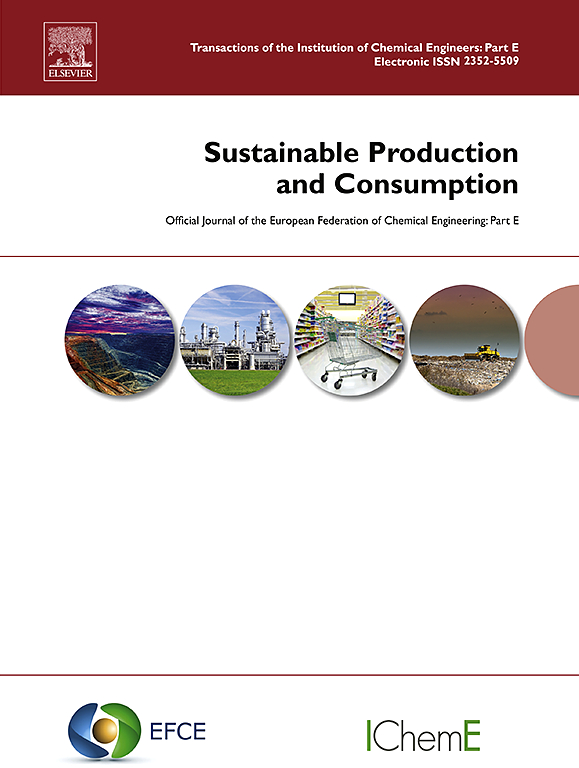Life cycle environmental and economic viability analysis of CO2 utilization for chemical production in the cement sector
IF 9.6
1区 环境科学与生态学
Q1 ENVIRONMENTAL STUDIES
引用次数: 0
Abstract
Transforming carbon dioxide emissions into marketable chemicals presents an attractive circular economy approach for emissions-intensive industries seeking decarbonization solutions. This study assesses carbon dioxide (CO2) utilization pathways in Thailand's cement industry for the production of urea, dimethyl ether (DME), and methanol by employing life cycle assessment, levelized cost analysis, and breakeven analysis under dynamic policy scenarios. At the midpoint level, urea and DME demonstrate favorable environmental profiles, with urea showing better performance in 16 out of 18 environmental indicators while DME exhibits advantages in 13 of the assessed categories. Methanol displays a more neutral profile with values close to zero across most categories. At endpoint level, all three CO2 utilization pathways outperform their conventional fossil-based counterparts across multiple categories. Urea shows the highest CO2 avoidance potential (3.47 kg CO2 per kg of CO2 utilized), which could potentially avoid emissions equivalent to 24 % of Thailand's total national emissions if all cement industry CO2 were utilized, followed by DME (1.65 kg CO2, 11 %) and methanol (0.77 kg CO2, 5 %). The cost analysis reveals that levelized production costs are highest for DME at USD 1544 per tonne, followed by methanol at USD 824 per tonne, and urea at USD 476 per tonne; however, these are significantly higher than conventional production methods. Several factors can close the cost gap between CO2-derived and conventional chemical production. Lower renewable electricity costs offer the most practical path to economic viability, as solar and wind energy prices have substantially decreased over the past decade, directly benefiting these electricity-intensive processes. Else, carbon credit support would be required ranging from USD 74/t-CO2 for urea to USD 310/t-CO2 for DME, with methanol requiring USD 216/t-CO2. A strategic approach for Thailand would combine declining renewable electricity costs with international market opportunities that value low-carbon products. The findings highlight urea production as the most promising pathway for Thailand's cement industry decarbonization efforts, while emphasizing the critical role of policy support in realizing the potential of these carbon capture and utilization pathways.
水泥行业化学生产中二氧化碳利用的生命周期环境和经济可行性分析
将二氧化碳排放转化为可销售的化学品,为寻求脱碳解决方案的排放密集型行业提供了一种有吸引力的循环经济方法。本研究通过采用生命周期评估、平准化成本分析和动态政策情景下的盈亏平衡分析,评估了泰国水泥行业用于生产尿素、二甲醚(DME)和甲醇的二氧化碳利用途径。在中点水平,尿素和二甲醚表现出良好的环境特征,尿素在18项环境指标中的16项表现更好,而二甲醚在13项评估类别中表现出优势。甲醇在大多数类别中表现出更中性的特征,其值接近于零。在终点水平上,这三种二氧化碳利用途径在多个类别上都优于传统的化石燃料利用途径。尿素显示出最高的二氧化碳避免潜力(每千克二氧化碳利用3.47千克二氧化碳),如果所有水泥工业的二氧化碳都被利用,可能会避免相当于泰国全国总排放量24%的排放量,其次是二甲醚(1.65千克二氧化碳,11%)和甲醇(0.77千克二氧化碳,5%)。成本分析显示,二甲醚的平准化生产成本最高,为1544美元/吨,其次是甲醇,为824美元/吨,尿素为476美元/吨;然而,这比传统的生产方法要高得多。有几个因素可以缩小二氧化碳衍生产品和传统化学品生产之间的成本差距。较低的可再生能源电力成本为经济可行性提供了最实际的途径,因为太阳能和风能的价格在过去十年中大幅下降,直接使这些电力密集型过程受益。否则,需要的碳信用支持范围从尿素74美元/t-CO2到二甲醚310美元/t-CO2,甲醇需要216美元/t-CO2。泰国的战略方针是将不断下降的可再生电力成本与重视低碳产品的国际市场机会结合起来。研究结果强调了尿素生产是泰国水泥行业脱碳工作最有希望的途径,同时强调了政策支持在实现这些碳捕获和利用途径潜力方面的关键作用。
本文章由计算机程序翻译,如有差异,请以英文原文为准。
求助全文
约1分钟内获得全文
求助全文
来源期刊

Sustainable Production and Consumption
Environmental Science-Environmental Engineering
CiteScore
17.40
自引率
7.40%
发文量
389
审稿时长
13 days
期刊介绍:
Sustainable production and consumption refers to the production and utilization of goods and services in a way that benefits society, is economically viable, and has minimal environmental impact throughout its entire lifespan. Our journal is dedicated to publishing top-notch interdisciplinary research and practical studies in this emerging field. We take a distinctive approach by examining the interplay between technology, consumption patterns, and policy to identify sustainable solutions for both production and consumption systems.
 求助内容:
求助内容: 应助结果提醒方式:
应助结果提醒方式:


